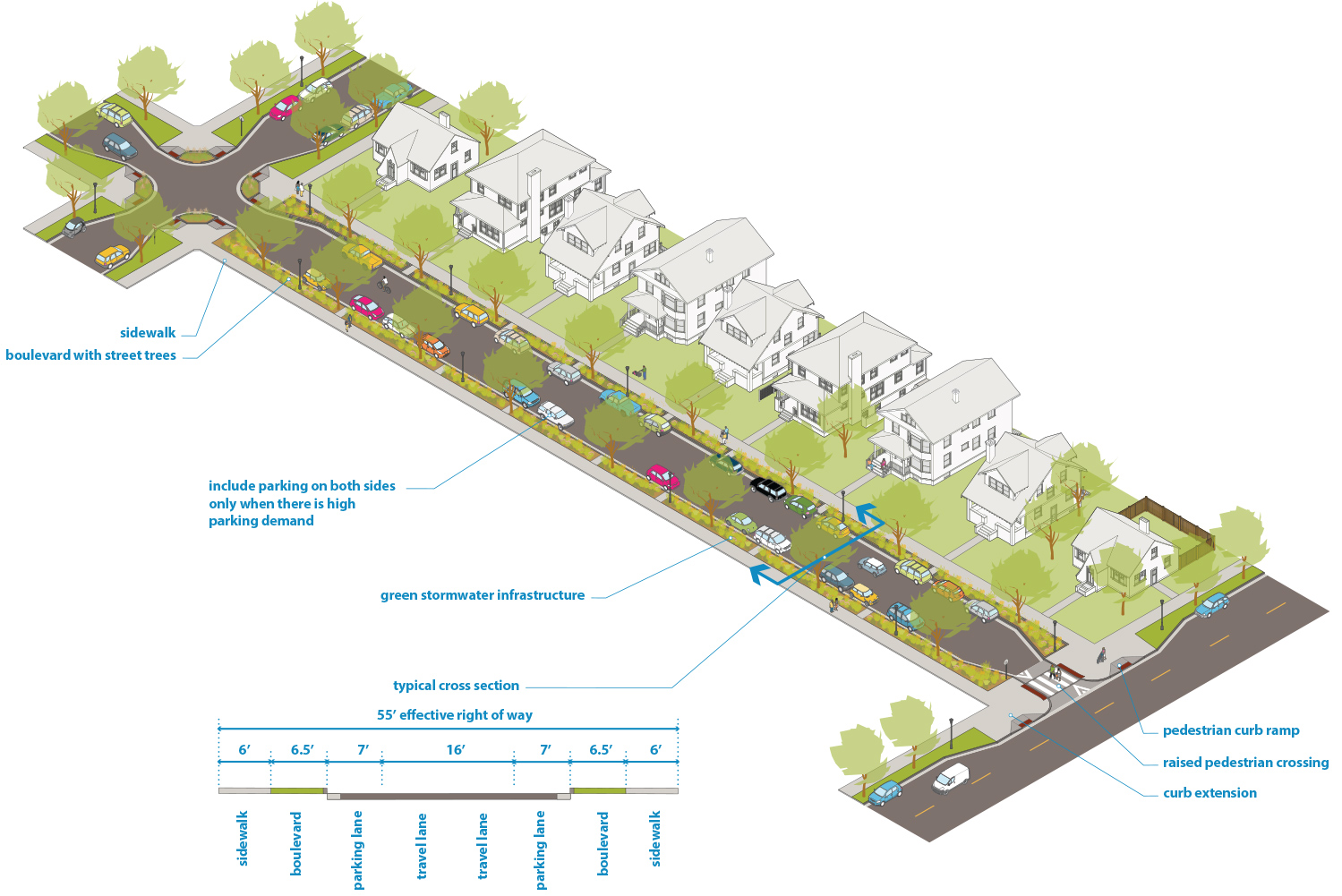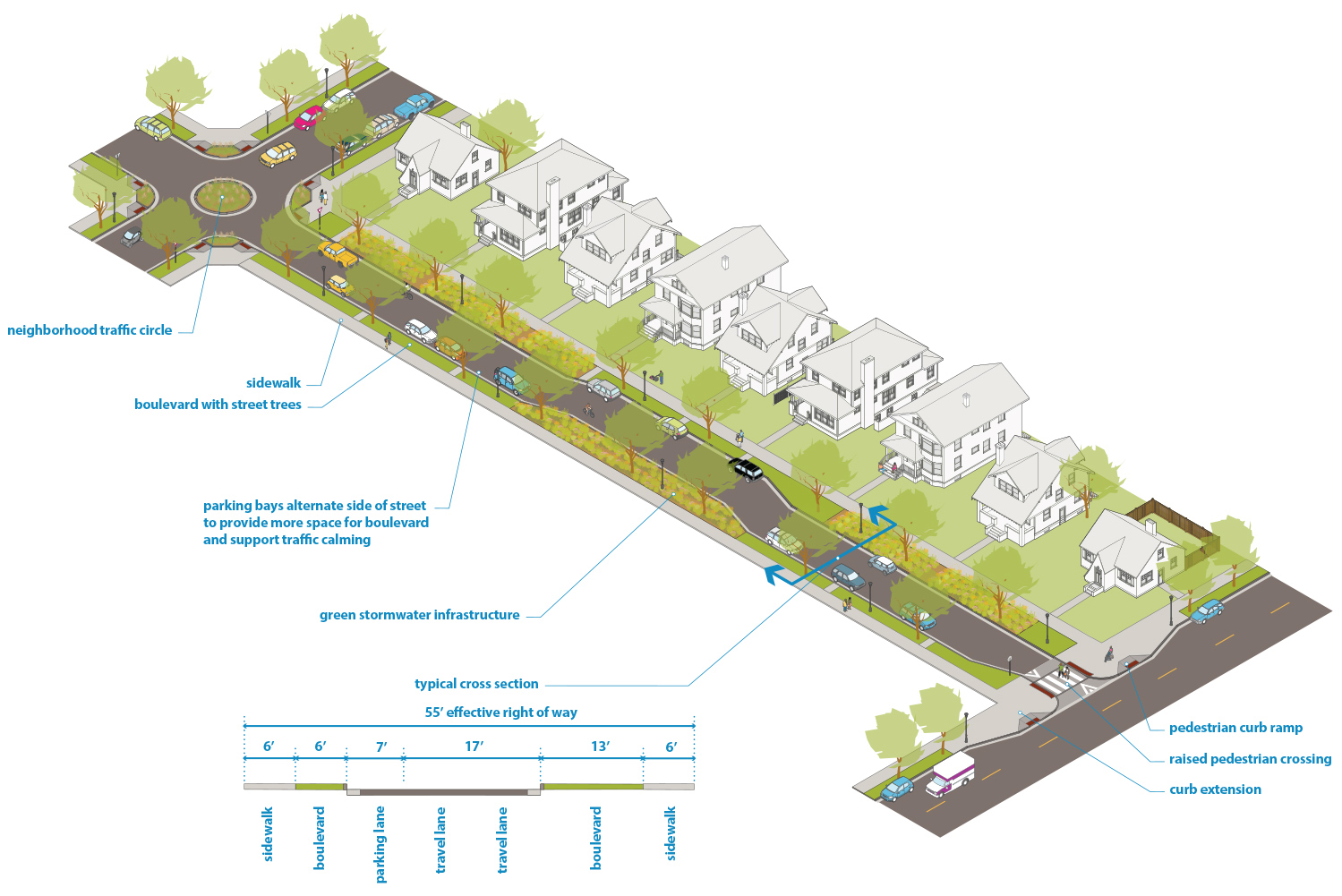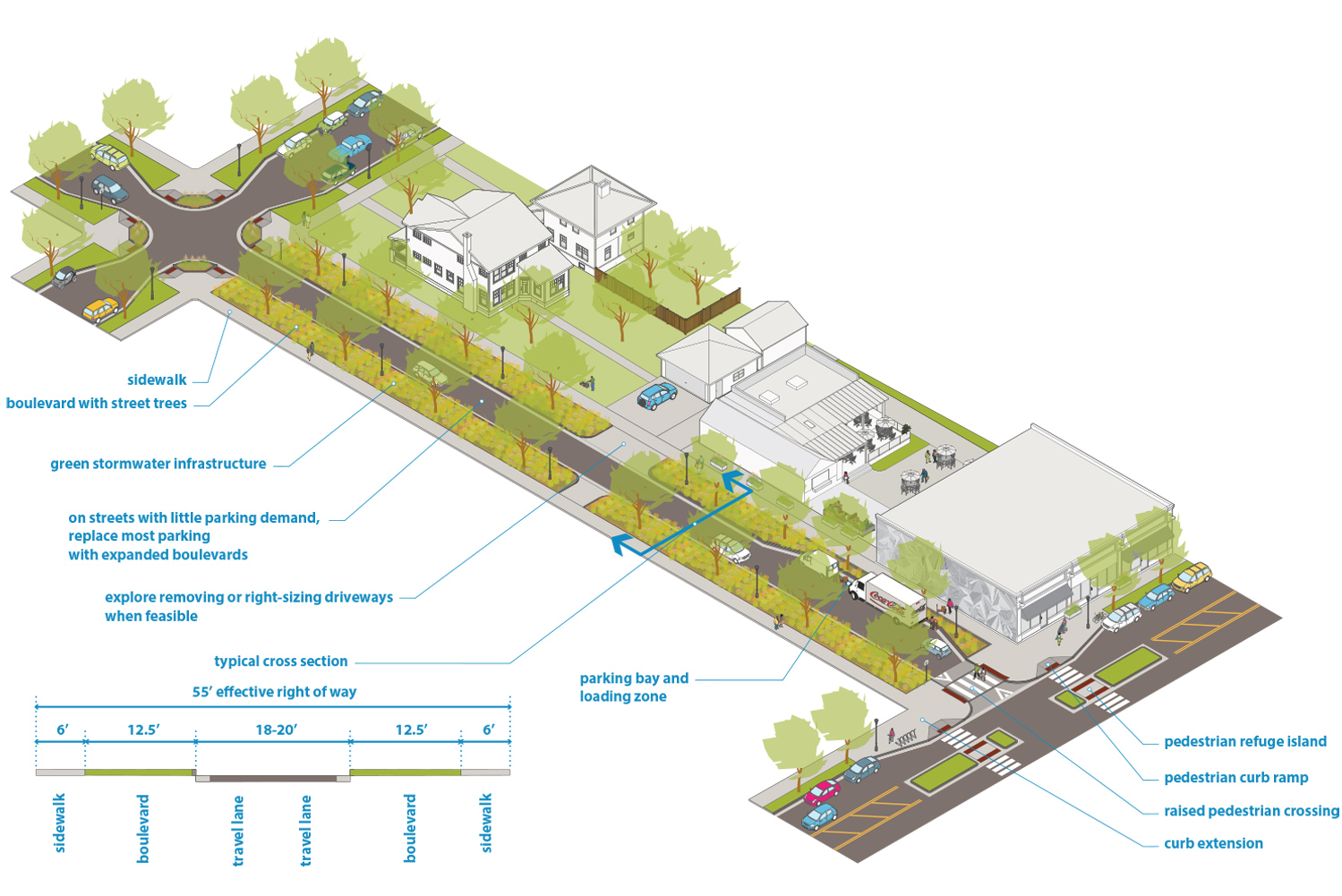Local residential streets with low traffic volumes that provide access to residences, parks, and schools.
Description
Urban Neighborhood streets are local residential streets with low traffic volumes (typically lower than 1,500 average daily traffic) and that provide access to residences, parks, and schools. Urban Neighborhood streets are the most predominant street type in the city. Urban Neighborhood streets are not intended for through motor vehicle trips.
Examples include Russell Avenue North, Buchanan Street Northeast, and 43rd Street.
Typical Characteristics
|
Miles
|
~720 miles
Approximately 65% of total street centerline mileage
|
|
Right of Way Width
|
Most commonly 60’ with some 66’, 80’, and other widths
|
|
Effective Right of Way
|
Varies; most commonly 55’
|
|
Functional Class
|
Local
|
|
Jurisdiction
|
City of Minneapolis
|
|
Route
|
- Local
- Municipal State Aid (limited number)
|
|
Modal Network
|
- Pedestrian Priority Network (rarely)
- All Ages and Abilities Bikeway Network (some)
|
|
Snow Emergency Route
|
Not typically
|
|
Historic Street
|
Includes a limited number of historic streets
|
Typical Design and Operations
See Street Design Guidance chapter for more information
|
Sidewalk
|
- 6’ typical pedestrian clear width
- 2’+ frontage width to any obstructions
See sidewalks guidance for more details.
|
|
Boulevard and Furnishing
|
- 5’+ typical width (6’+ when possible), including 8” wide curb
- Wider boulevard and furnishing zones should be used when feasible to support features that make the pedestrian environment more attractive and comfortable, support street tree health, and maximize green stormwater infrastructure.
See boulevards and furnishings guidance for more details.
|
|
Bikeway
|
For streets on the All Ages and Abilities bikeway network, neighborhood greenways should be used (either full greenway or bicycle boulevard, depending on context).
|
|
Transit
|
Very few streets include limited local bus service, typically to access route layover locations. Where regular local bus service exists or is planned, consider widening the roadway by approximately 2’ from typical widths to support and see bus stops guidance. School buses typically use Urban Neighborhood streets and are reflected in guidance.
|
|
Freight
|
Not on the Truck Route Network, but local business access and deliveries are permitted.
|
|
Roadway
|
- The amount of motor vehicle parking should typically be right sized to target greater than 60% occupancy to reduce speeding and maximize greening. Streets will often combine sections of no parking, parking on both sides, and parking on one side to maximize greening and traffic calming. Extra consideration should be made to replace parking with expanded greening on “short block” Urban Neighborhood streets, which often have no or few properties directly fronting them.
- 30’ typical width for a two-way or one-way street with parking on both sides, including 2’ gutters on each side
- For streets with greater than 75% average parking utilization, see design guidance for options to manage winter access.
- 24’ typical width for two-way street with parking on one side, including 2’ gutters on each side
- For streets with greater than 75% average parking utilization, see design guidance for options to manage winter access.
- 18’ to 20’ typical width for two-way street with no parking, including 2’ gutters on each side
- For blocks without parking on either side, generally include one or more 7’ loading/unloading zone, which also provides space for winter passing zones. See vehicle parking and curbside uses guidance for more detail.
- 18’ to 20’ typical width for one-way street with parking on one side, including 2’ gutters on each side
- This configuration will most commonly be parried with a neighborhood greenway, which provides additional space if needed for fire truck access. Designers should coordinate with the Fire department to ensure winter fire truck access.
- For streets with greater than 75% average parking utilization, see design guidance for options to manage winter access.
- The roadway should include traffic calming features that reduce speed and limit through travel by motor vehicles. See neighborhood traffic calming guidance for more details.
- One-way streets are generally discouraged unless connected with a neighborhood greenway because they can lead to more speeding.
- Lane markings should not typically be included and users negotiate in a narrow, shared space.
|
|
Design speed
|
20 mph
See design speed guidance for more detail.
|
|
Design vehicle
|
Most commonly DL-23, but can also be SU-30 or WB-40 depending on intersecting street and context.
See design and control vehicles guidance for more details.
|
|
Control vehicle
|
Generally Aerial Fire Truck Mid Mount 100.
See design and control vehicles guidance for more details.
|
|
Motor Vehicle Property Access
|
- New driveways should be limited to locations without alley or cross street access.
- Designers should explore removing driveways that are no longer being used, are no longer permitted, or where access is provided via an alley. Designers should also explore right-sizing driveway curb cuts.
See driveways guidance for more details.
|
|
Intersection Traffic Control
|
Stop control or yield control
|
|
Intersection details
|
- Traffic circles should be considered for intersecting Urban Neighborhood streets.
- Raised pedestrian crossings should generally be included across Urban Neighborhood streets when there is a high-volume pedestrian crossing (most typically along Mixed Use Commercial streets) or All Ages and Abilities bikeway network crossing.
|
Typical Cross Sections
Figure 2.3.1
2-way Urban Neighborhood street with parking on both sides (55’ effective right of way)

Download Figure 2.3.1
Figure 2.3.2:
2-way Urban Neighborhood street with parking on one side (55’ effective right of way)

Download Figure 2.3.2
Figure 2.3.3:
2-way Urban Neighborhood street with no parking (55’ effective right of way)

Download Figure 2.3.3







